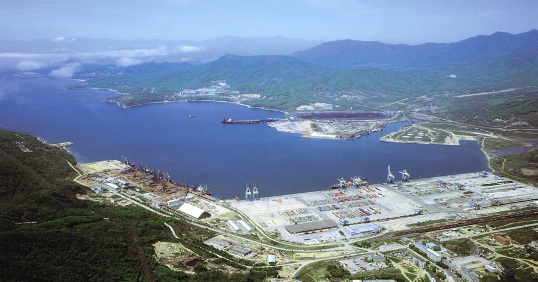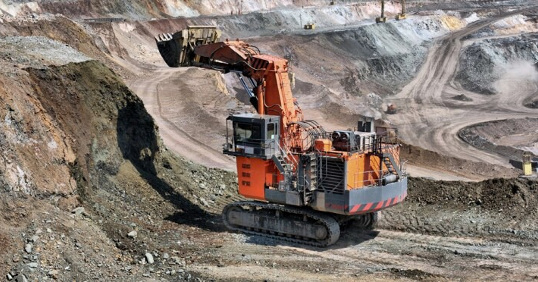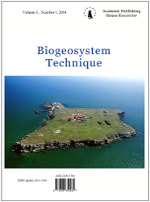1 June 25, 2025
Articles
1. Rafek R. Abdullin, Maxim V. Dyuldin, Denis A. Egorov, Natalia V. Krupenina Evgeniy O. Olkhovik, Yuriy K. Smirnov, Alexey V. Cheremisin, Igor A. Chernov, Dilan Kouam, Chenxi Guo, Vasliy Y. Rud
Monitoring the Condition of Hydraulic Structures during the Inter-Flood Period
Biogeosystem Technique. 2025. 12(1): 3-14.
Number of views: 125 Download in PDF
2. Rafek R. Abdullin, Maxim V. Dyuldin, Denis A. Egorov, Natalia V. Krupenina, Eugeny O. Olkhovik, Vladimir V. Karetnikov, Yuri K. Smirnov, Vasily Y. Rud, Daria A. Valiullina, Zhenyue Yuan, Van Yuikun, Alexey V. Cheremisin, Igor A. ChernovBiogeosystem Technique. 2025. 12(1): 3-14.
Abstract:
The article is devoted to the issues of operational monitoring of the state of the infrastructure of hydraulic structures in the inter-flood period after the active impact of a powerful water flow during an ice break. For the design of repair and restoration works, a thorough examination of the condition of the riverbed and walls of hydraulic structures is necessary, on the basis of which a visual three-dimensional model is built. For visual observation, it is proposed to use a water drone equipped with pressure and temperature sensors, as well as a gyroscope-accelerometer and a magnetic compass. The main objective of the study is to plan the trajectory of a water drone in the reservoir area in order to build the most adequate model of its depths, the condition of the mooring walls and coastal slopes, with the recording of sensor readings in a database and operational visualization of the data obtained. To examine the condition of the walls of hydraulic structures, both visual and instrumental built-in monitoring tools are used to track the values of the main indicators of the condition of reinforced concrete structures. Monitoring of the groundwater level is a prerequisite for the adequate functioning of hydraulic structures. This is necessary for modeling the hydrological balance, which allows making informed decisions on water resources management and preventing negative consequences for the environment. It is also very important to monitor the depths of the fairway and the condition of the coastal slopes.
The article is devoted to the issues of operational monitoring of the state of the infrastructure of hydraulic structures in the inter-flood period after the active impact of a powerful water flow during an ice break. For the design of repair and restoration works, a thorough examination of the condition of the riverbed and walls of hydraulic structures is necessary, on the basis of which a visual three-dimensional model is built. For visual observation, it is proposed to use a water drone equipped with pressure and temperature sensors, as well as a gyroscope-accelerometer and a magnetic compass. The main objective of the study is to plan the trajectory of a water drone in the reservoir area in order to build the most adequate model of its depths, the condition of the mooring walls and coastal slopes, with the recording of sensor readings in a database and operational visualization of the data obtained. To examine the condition of the walls of hydraulic structures, both visual and instrumental built-in monitoring tools are used to track the values of the main indicators of the condition of reinforced concrete structures. Monitoring of the groundwater level is a prerequisite for the adequate functioning of hydraulic structures. This is necessary for modeling the hydrological balance, which allows making informed decisions on water resources management and preventing negative consequences for the environment. It is also very important to monitor the depths of the fairway and the condition of the coastal slopes.
Number of views: 125 Download in PDF
The Problem of Data Compromise in the Era of Quantum Computing
Biogeosystem Technique. 2025. 12(1): 15-24.
Number of views: 155 Download in PDF
3. Artyom Kirakosyan, Astghik Sukiasyan, Alla Okolelova, Silva Gevorgyan, Tatiana Stratulat, Anahit AtoyantsBiogeosystem Technique. 2025. 12(1): 15-24.
Abstract:
Solving modern problems of ecology and the environment requires the use of large amounts of data and, accordingly, the use of quantum computers and artificial intelligence. This article examines the challenges associated with ensuring secure information exchange in the context of integrating quantum computers into communication networks. These quantum computers possess significantly higher processing speeds compared to standard von Neumann architecture computers. Considering that symmetric and asymmetric encryption algorithms rely on the assumption that breaking the used ciphers within a reasonable timeframe is practically impossible, the advent of quantum computers with their immense computational power calls into question the long-term stability of these ciphers. The primary threat posed by quantum computers is data compromise, which involves intercepting and accumulating encrypted data for future decryption attempts. To mitigate this threat, it is proposed to use a neural network to classify suspicious logs recorded by the operating system's security subsystem.
Solving modern problems of ecology and the environment requires the use of large amounts of data and, accordingly, the use of quantum computers and artificial intelligence. This article examines the challenges associated with ensuring secure information exchange in the context of integrating quantum computers into communication networks. These quantum computers possess significantly higher processing speeds compared to standard von Neumann architecture computers. Considering that symmetric and asymmetric encryption algorithms rely on the assumption that breaking the used ciphers within a reasonable timeframe is practically impossible, the advent of quantum computers with their immense computational power calls into question the long-term stability of these ciphers. The primary threat posed by quantum computers is data compromise, which involves intercepting and accumulating encrypted data for future decryption attempts. To mitigate this threat, it is proposed to use a neural network to classify suspicious logs recorded by the operating system's security subsystem.
Number of views: 155 Download in PDF
Medico-Ecological Approaches to Plant Research
Biogeosystem Technique. 2025. 12(1): 25-35.
Number of views: 132 Download in PDF
4. Abhishek Singh, Armine Chakhmakhchyan, Nare Darbinyan, Sakshi Singh, Ani Hayrapetyan, Rupesh Kumar Singh, João Ricardo Sousa, Derdzyan Tatevik, Hrant Khachatryan, Karen GhazaryanBiogeosystem Technique. 2025. 12(1): 25-35.
Abstract:
The primary task of environmental protection is to ensure the safety of territories and promote their sustainable development. At the same time, analysing the current ecological situation in a specific area, including identifying spatio-temporal changes within its boundaries, is a complex undertaking that requires an integrated approach. This article proposes methods that use annual and perennial plants as natural targets for analysing the accumulation and migration of potentially toxic elements in the soil. In this sense, studying plant ecotypes already adapted to specific growing conditions is of significant practical importance. To gain a complete understanding of current circumstances, the study compared the indicators of geoecological indices related to the accumulation and migration of potentially toxic elements in the soil with the antioxidant potential of plants and their bioaccumulate capacity is important to emphasise, as the accumulation of potentially toxic elements in plants is most influenced by their genotype. Primary and secondary metabolic processes also play a role in the process of peroxidation in lipidcontaining structures that are sensitive to pH, temperature, and other physicochemical parameters. Therefore, the acquisition of quantitative and qualitative data on the movement of potentially toxic elements in the soil-plant system is essential for a reliable assessment of the degree of environmental pollution.
The primary task of environmental protection is to ensure the safety of territories and promote their sustainable development. At the same time, analysing the current ecological situation in a specific area, including identifying spatio-temporal changes within its boundaries, is a complex undertaking that requires an integrated approach. This article proposes methods that use annual and perennial plants as natural targets for analysing the accumulation and migration of potentially toxic elements in the soil. In this sense, studying plant ecotypes already adapted to specific growing conditions is of significant practical importance. To gain a complete understanding of current circumstances, the study compared the indicators of geoecological indices related to the accumulation and migration of potentially toxic elements in the soil with the antioxidant potential of plants and their bioaccumulate capacity is important to emphasise, as the accumulation of potentially toxic elements in plants is most influenced by their genotype. Primary and secondary metabolic processes also play a role in the process of peroxidation in lipidcontaining structures that are sensitive to pH, temperature, and other physicochemical parameters. Therefore, the acquisition of quantitative and qualitative data on the movement of potentially toxic elements in the soil-plant system is essential for a reliable assessment of the degree of environmental pollution.
Number of views: 132 Download in PDF
Sustainable Management of Saline Soils: Insights into Organic Amendments for Enhancing Soil Health and Crop Resilience
Biogeosystem Technique. 2025. 12(1): 36-47.
Number of views: 159 Download in PDF
5. Ha Thi Nguyen Thuy, Tamara S. Astarkhanova, Alla A. Okolelova, Van Tran QuangBiogeosystem Technique. 2025. 12(1): 36-47.
Abstract:
Soil salinization, whether induced by nature or by humans, is an increasingly pressing global issue. This problem threatens agro-ecosystems since salt stress affects most farmed plants, reducing both the quality and amount of food produced. There have been a lot of new strategies and techniques developed in the last several years to help plants deal with salt stress and lessen its effects on crops. Unfortunately, not all of them are eco-friendly. That is why it is so important to find sustainable ways to improve soil production in salty environments without harming them in the long run. A lot more people are starting to pay attention to organic amendments like vermicompost (VC), vermi-wash (VW), biochar (BC), and bio-fertilizers (BF). The organic supplement lessens the effects of salt stress and boosts the development, growth, and harvest of crops. According various previous research on organic amendments after application of these organic products it enhances plant growth and yield, boost salt tolerance, and modify ionic balance, photosynthetic processes, antioxidant systems, and oxidative stress reduction. This review discusses recent studies on organic amendments in salt-stressed plants and their role in stress alleviation. The current assessment explores both existing and potential future applications of organic amendments.
Soil salinization, whether induced by nature or by humans, is an increasingly pressing global issue. This problem threatens agro-ecosystems since salt stress affects most farmed plants, reducing both the quality and amount of food produced. There have been a lot of new strategies and techniques developed in the last several years to help plants deal with salt stress and lessen its effects on crops. Unfortunately, not all of them are eco-friendly. That is why it is so important to find sustainable ways to improve soil production in salty environments without harming them in the long run. A lot more people are starting to pay attention to organic amendments like vermicompost (VC), vermi-wash (VW), biochar (BC), and bio-fertilizers (BF). The organic supplement lessens the effects of salt stress and boosts the development, growth, and harvest of crops. According various previous research on organic amendments after application of these organic products it enhances plant growth and yield, boost salt tolerance, and modify ionic balance, photosynthetic processes, antioxidant systems, and oxidative stress reduction. This review discusses recent studies on organic amendments in salt-stressed plants and their role in stress alleviation. The current assessment explores both existing and potential future applications of organic amendments.
Number of views: 159 Download in PDF
Assessment of Soil Erosion and Mitigation Strategies in Nghe An Province, Vietnam under Tropical Monsoon Conditions
Biogeosystem Technique. 2025. 12(1): 48-60.
Number of views: 202 Download in PDF
6. Biogeosystem Technique. 2025. 12(1): 48-60.
Abstract:
This study on soil erosion in Thanh Chuong, Nghe An Province (Vietnam) utilized GIS, remote sensing, and the RUSLE model to assess and quantify erosion dynamics. It was found that soil erosion is primarily influenced by the intensity and duration of monsoon rainfall, while the erosion resistance of landscapes is determined by factors such as slope, vegetation cover, and precipitation. High erosion rates were observed in areas where land use was mismatched with local agro-climatic conditions, leading to significant soil loss. The agroecological assessment revealed that 18 % of the study area experiences high to very high erosion, with an average annual soil loss of 25 T/ha. Erosion data were categorized based on three agricultural systems: tea and citrus cultivation along contour lines, annual crops on sloping lands, and perennial crops such as acacia and cassava. Using remote sensing and GIS, erosion was classified into five levels, ranging from very low to very high, while LS-Factor assessments from Landsat 8 images were divided into eight classes. To combat erosion, the study proposes several mitigation measures, including evaluating vegetation cover for anti-erosion efficiency, constructing trenches and embankments, creating terraced slopes, and optimizing agricultural and forestry practices through the SALT models for heavily eroded lands.
This study on soil erosion in Thanh Chuong, Nghe An Province (Vietnam) utilized GIS, remote sensing, and the RUSLE model to assess and quantify erosion dynamics. It was found that soil erosion is primarily influenced by the intensity and duration of monsoon rainfall, while the erosion resistance of landscapes is determined by factors such as slope, vegetation cover, and precipitation. High erosion rates were observed in areas where land use was mismatched with local agro-climatic conditions, leading to significant soil loss. The agroecological assessment revealed that 18 % of the study area experiences high to very high erosion, with an average annual soil loss of 25 T/ha. Erosion data were categorized based on three agricultural systems: tea and citrus cultivation along contour lines, annual crops on sloping lands, and perennial crops such as acacia and cassava. Using remote sensing and GIS, erosion was classified into five levels, ranging from very low to very high, while LS-Factor assessments from Landsat 8 images were divided into eight classes. To combat erosion, the study proposes several mitigation measures, including evaluating vegetation cover for anti-erosion efficiency, constructing trenches and embankments, creating terraced slopes, and optimizing agricultural and forestry practices through the SALT models for heavily eroded lands.
Number of views: 202 Download in PDF








